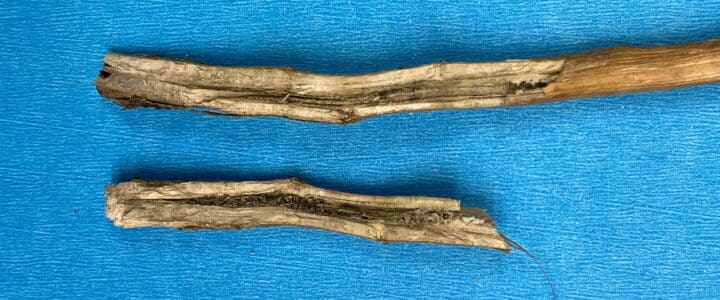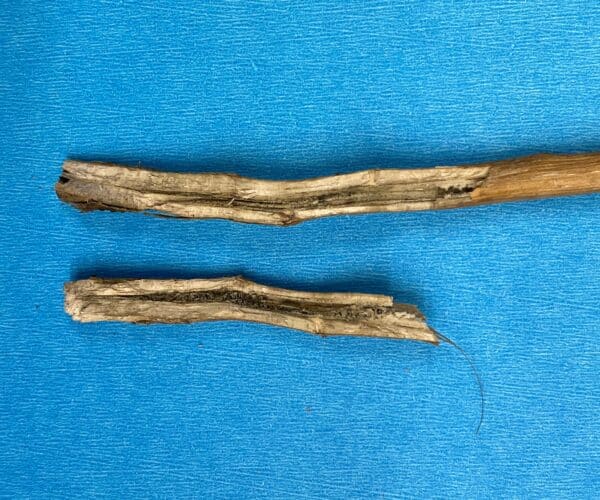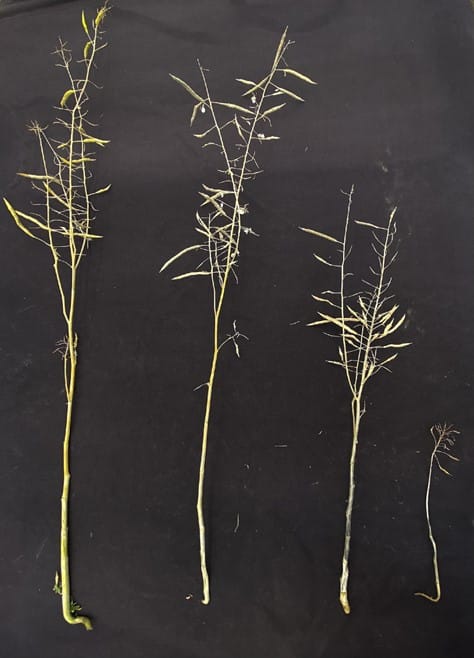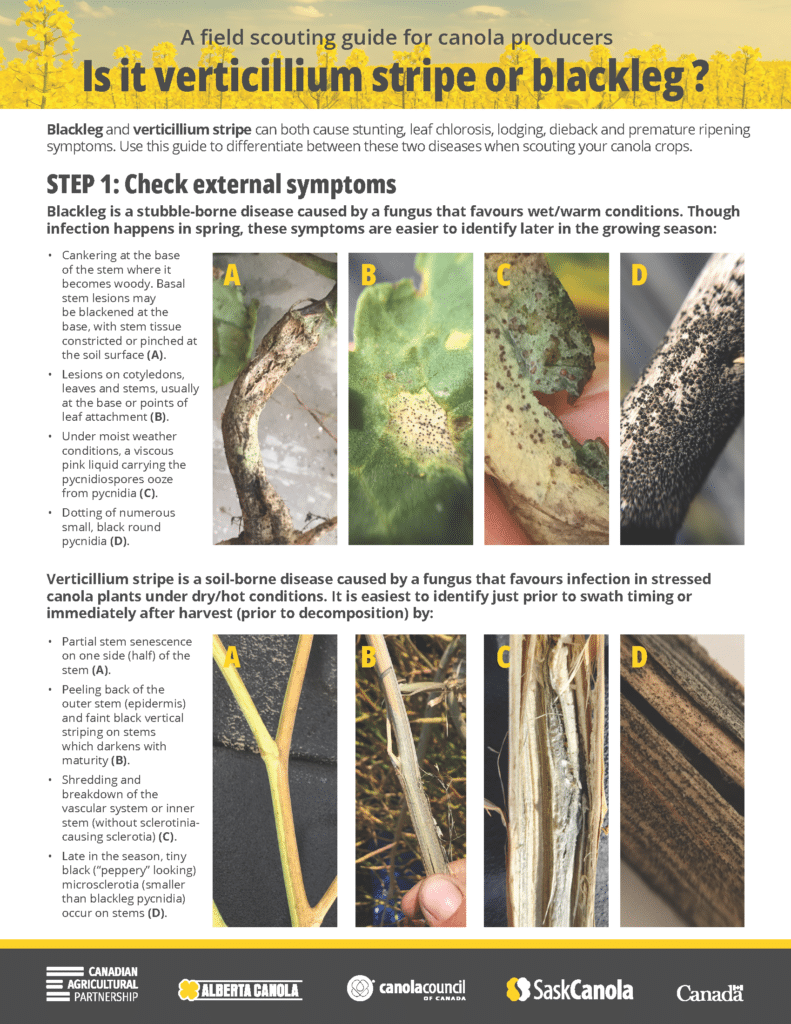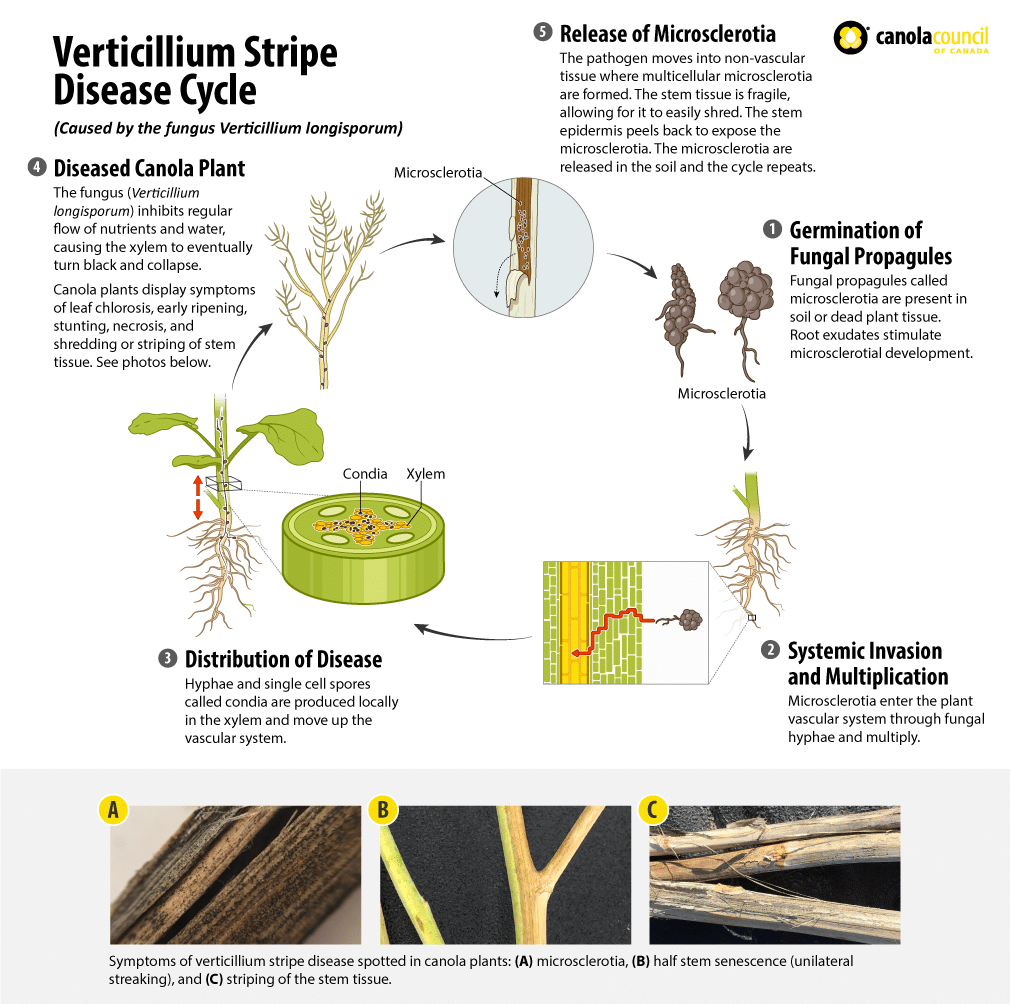Photo credit: Yixiao (Becky) Wang
Verticillium stripe of canola is caused by the fungal species Verticillium longisporum and is a fairly new in western Canada. It is one of the diseases that surveyors watch for in their annual Manitoba, Saskatchewan and Alberta disease surveys and canola growers are concerned about potential yield loss that it may cause. While research has been conducted on verticillium stripe in canola, there are still many knowledge gaps related to this disease and the impact it has on canola.
The five-year (2019-2024) Verticillium Stripe – The Disease Management project, led by Dr. Hwang and Dr. Strelkov, investigated the disease development, evaluated canola genotypes for resistance and examined its interactions with blackleg. It aimed to help farmers and industry predict the impact of this disease, facilitate further research into verticillium stripe more efficiently and to more effectively screen genetic material for resistance to the pathogen.
More specifically, the project objectives include:
1) Measure yield loss by evaluating the effects of inoculum density on disease intensity was evaluated and creating a model to related these two factors.
2) Quantify the effects of inoculation at different growth stages of canola and using different techniques.
3) Evaluate canola genotypes for resistance to verticillium stripe.
4) Determine the interacting effects of verticillium stripe and blackleg.
Apply this on your farm
- Watch the Identifying Verticillium Stripe video before scouting.
- Use this field scouting guide and the verticillium stripe article to help differentiate it from blackleg.
- Collect and submit suspect canola samples for verticillium stripe testing, using this video for reference.
- Further strengthen blackleg control efforts, with the help of the Blackleg Management Guide, Understanding Blackleg Resistance and using blackleg race tests.
- Reduce soil movement to reduce risk of microsclerotia (the fungal bodies that cause verticillium stripe) movement.
Methods
Researchers measured yield losses in two ways: on a per-plant basis by growing plants in micro-plots inoculated at different densities, and by growing plants in six by 1.5 metre field plots harvested by small-plot combine. They used greenhouse experiments to determine interactions between blackleg and verticillium stripe.
Weather conditions were moister than average in the early growing season and resulted in good disease development in the 2020 field experiments. In 2021, precipitation was well below average in June and July and resulted in much lower disease development, however yield losses still occurred.
Results
Verticillium stripe infecting canola in the early stages inhibited canola establishment and growth. Later infection led to deterioration of the stem and vascular tissues. Infection at both stages affected yield and yield loss increased as the infections became more severe.
- A verticillium stripe disease severity assessment scale (0-6) was proposed to evaluate disease severity in canola seedlings, and a 0-4 scale was developed for this evaluation in mature plants. The capacity to assess disease at different growth stages is important for distinguishing between different types of resistance (such as quantitative vs. qualitative) that may be active at different times, and provides a measure of disease progression. It could also be used by canola breeders to evaluate the disease in future canola lines.
- Plants were assessed for disease severity at the end of the growing season, as verticillium stripe symptoms can be easily recognized at this time.
- Yield losses increased with disease severity and occurred without obvious symptoms under low moisture.
- In the 0-6 scale, 0 = no symptoms; 1 = yellowing of cotyledons; 2 = yellowing and partial necrosis of cotyledons, some reduced growth of first true leaves; 3 = death of cotyledons, seedling stunted; 4 = death of cotyledons, seedling stunted, true leaves yellow; 5 = death of cotyledons, seedling stunted, little to no growth of true leaves; and 6 = seedling entirely necrotic.
- In the 0-4 scale, 0 = no symptoms or signs of disease; 1 = some discolouration of main stem, with dark unilateral stripe; 2 = discolouration of main stem, microsclerotia on ≤ 25% of the surface, slight stunting of entire plant; 3 = discoloration of main stem, some shredding of the epidermis, microsclerotia on ≤ 75% of the surface, stunting of entire plant; 4 = stem entirely necrotic and covered with microsclerotia, shredding of the epidermis, plant severely stunted.
- Greenhouse experiments of this research reported that canola infected with both blackleg and verticillium stripe had increased blackleg severity, but blackleg didn’t increase the severity of verticillium stripe. Read more on this in the Blackleg Yield Losses and Interactions with Verticillium Stripe in Canola (Brassica napus) in Canada paper.
- Future studies could examine the effects of inoculum timing on their combined effects.
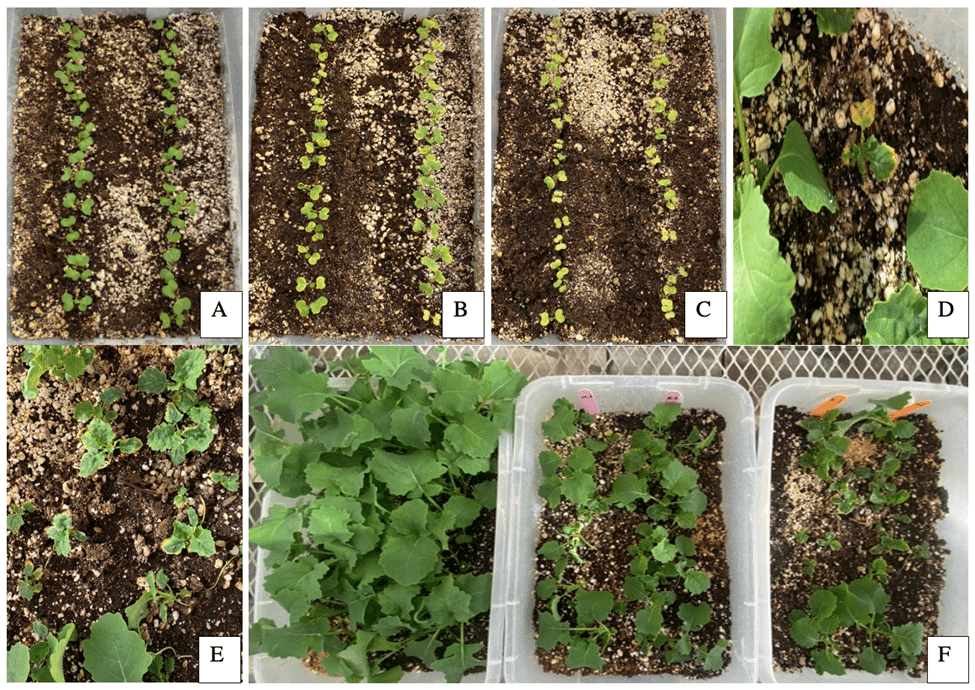
- Verticillium stripe symptoms were observed and recorded, including ways to differentiate it from blackleg. This includes:
- The microsclerotia of V. longisporum (which causes verticillium stripe) were much smaller and more grey than the pycnidia produced by L. maculans (which causes blackleg).
- While verticillium stripe and blackleg both cause vascular discoloration, the cross-sections at the base of the stem of plants with blackleg were darker (black) and more discrete than the grey, more diffuse verticillium stripe-infected stems.
- Longitudinal sections of the stem further served to distinguish the two diseases. In blackleg-infected plant, the vascular discoloration was restricted to the lower stem, affecting the cortex and epidermis. While plant infected by verticillium stripe, had symptoms extending up the stem, with a hollow, darker centre. When plants were infected by both diseases, longitudinal sections revealed a hollow and darker centre together with black discoloration of the cortex and epidermis.
- Improved methods for inoculating canola with the verticillium stripe-causing fungus, Verticillium longisporum, were developed during this project. This is important for screening canola germplasm and more accurately evaluating resistance in canola.
Management considerations
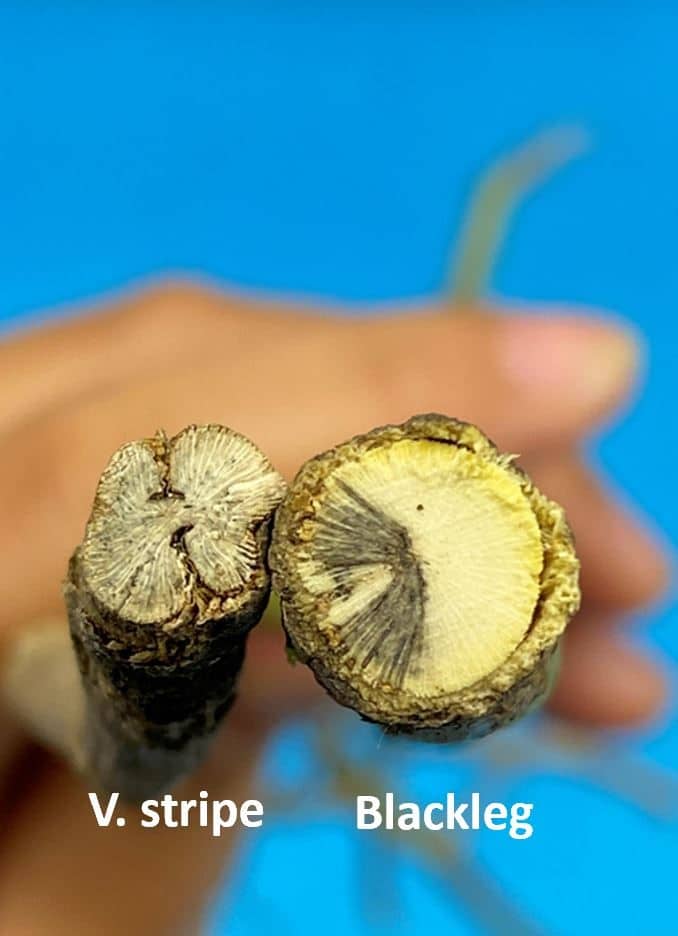
- Identify verticillium stripe and differentiate it from blackleg and other canola diseases, using the Verticillium stripe field scouting guide and checking out the How to identify verticillium stripe Canola Watch fundamentals article, as well as watching the Identifying Verticillium Stripe video (below).
- Collect and submit suspect canola stem samples for testing (see lab options here, in the Canola Encyclopedia), remembering to request that samples are tested for both verticillium stripe and blackleg.
- Extra measures may be needed to control blackleg where verticillium stripe is present (to help reduce the risk of blackleg severity). This can include using the Blackleg Management Guide can support and improve your continued blackleg management efforts.
- When submitting stem or stubble samples for blackleg testing, then watch this How to interpret blackleg race tests video and use the Understanding Blackleg Resistance guide to help you choose resistant cultivars for next year.
- Reduce soil movement between fields to reduce the risk of introducing verticillium stripe to a field. Soil that contains small, long-lived verticillium stripe fungal propagules called microsclerotia (which are present in infected canola stems) can help spread the disease. See how microsclerotia impacts the Verticillium stripe disease cycle.
For more information, read the full project summary and final report.
Verticillium videos
Related research
- To learn about additional verticillium stripe research findings, visit these project pages:
- The seven ongoing verticillium stripe projects will search for further information to better inform management decisions.
Published August 29, 2024


